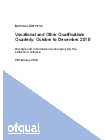Vocational and other qualifications quarterly: October to December 2018

Statistics on vocational and other qualifications, excluding GCSEs, AS levels, A levels, and the Diploma and its components.
Documents
Vocational and other qualifications quarterly: October to December 2018
Ref: Ofqual/19/6479/1MS Excel Spreadsheet, 475KB
This file may not be suitable for users of assistive technology. Request an accessible format.
If you use assistive technology (such as a screen reader) and need aversion of this document in a more accessible format, please email [email protected].Please tell us what format you need. It will help us if you say what assistive technology you use.

Background information – Vocational and other qualifications quarterly: October to December 2018
Ref: Ofqual/18/6479/2PDF, 544KB, 10 pages
This file may not be suitable for users of assistive technology. Request an accessible format.
If you use assistive technology (such as a screen reader) and need aversion of this document in a more accessible format, please email [email protected].Please tell us what format you need. It will help us if you say what assistive technology you use.
Table of revisions
MS Excel Spreadsheet, 10.1KB
This file may not be suitable for users of assistive technology. Request an accessible format.
If you use assistive technology (such as a screen reader) and need aversion of this document in a more accessible format, please email [email protected].Please tell us what format you need. It will help us if you say what assistive technology you use.
Pre-release access list for vocational and other qualifications quarterly: October to December 2018
HTML
Details
Main trends
The main trends for quarter 4 2018 are given below:
- Just over 1 million certificates were awarded in 2018 Q4, an increase of 6.6% on the same quarter of 2017.
- The increase is mostly due to an increase in the number of certificates in Vocationally-Related Qualifications, English for Speakers of Other Languages, Other Life Skills Qualifications and Other Vocational Qualifications. There have been decreases in the number of certificates in QCF and Functional Skills.
- The decline in the number of certificates in QCF can be partially attributed to Ofqual’s decision to revise the list of available qualification types. The increase in the number of certificates in Vocationally-Related Qualifications, English for Speakers of Other Languages, Other Life Skills, and Other Vocational Qualifications can also be attributed to this revision.
- The general decline in the number of certificates over the previous 12 month period may be caused by a tightening in the availability of funding. This is notable at Level 1/Level 2 and Level 2 qualifications. Some of this decline has been offset somewhat by the increase in the number of certificates in Level 3 qualifications. This change could be driven by changes in performance tables as Applied General qualifications (Level 3) grow in popularity.
- The decline in the number of certificates in Functional Skills is likely due to the changes in funding rules by the Education and Skills Funding Agency and revised guidance from DfE that post 16 students who have a grade D/grade 3 in English or mathematics must now be entered for GCSE resits in those subjects rather than Functional Skills.
- The sector subject areas with a notable increase in the number of certificates were Preparation for Life and Work and Construction, Planning and the Built Environment.
- The increase in the number of certificates in Preparation for Life and Work is due to the increase in the number of certificates in a number of Entry Level qualifications compared to Q4 in 2017.
- The qualification with the highest number of certificates this quarter was QA Level 3 Award in Emergency First Aid at Work (RQF), followed by TCL Entry Level Certificate in ESOL International – Speaking and Listening (Entry 3) and City & Guilds Level 3 Award in the Requirements for Electrical Installations BS 7671:2018.
- The increase in the number of certificates over the previous 12 month period for The Learning Machine is driven by increases in the number of certificates in the Information and Communication Technology sector subject area, and the increase in ESB is due to an increase in the number of certificates in Entry Level and Level 1 qualifications. The decrease in the number of certificates awarded by AQA can be explained by the removal of some Level1/ Level 2 qualifications from school perfomance tables in 2017.
Geographical coverage
The data cover regulated qualifications in England.
Datasets
The dataset used to produce this release is available separately.
Statistics collection
All our published vocational and other qualifications publications are available at a single collection page.
User feedback
We welcome your feedback on our publications. Should you have any comments on this statistical release and how to improve it to meet your needs please contact us at [email protected].











Responses